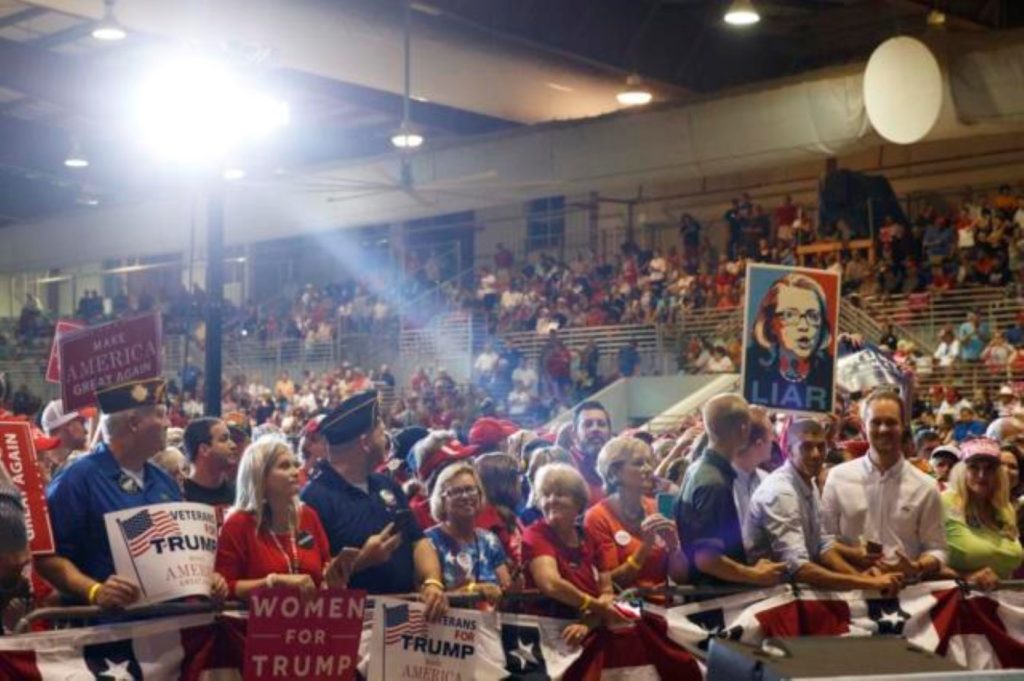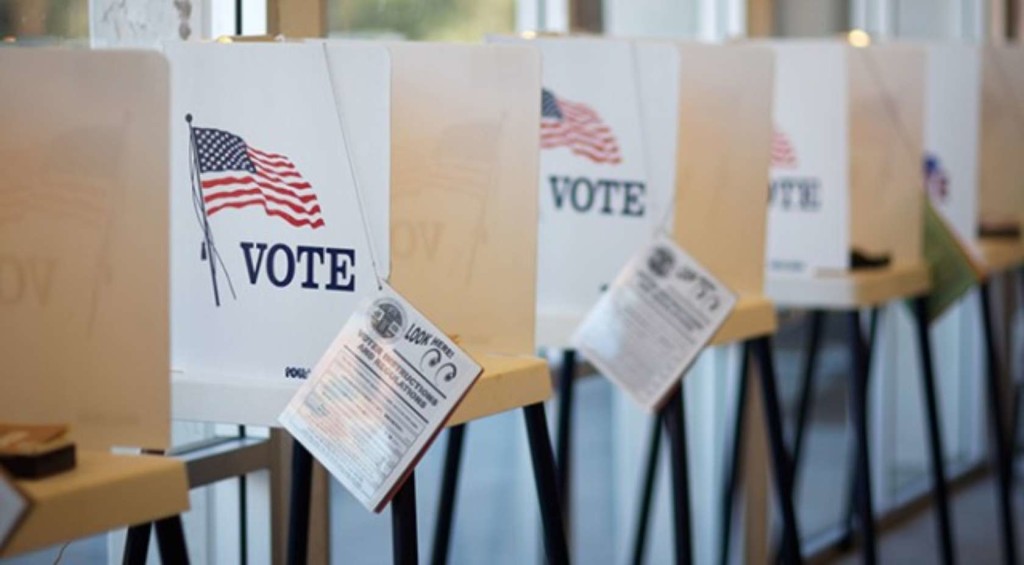Donald Trump tells backers to ‘watch the polls’ — but signups slow

Donald Trump regularly warns his crowds to closely watch polling places to prevent Democrats from stealing the election. But his campaign has failed to enlist many to serve as official poll watchers in major population centers, according to spot checks by The Associated Press. In some key regions, Democratic monitors will far outnumber Republicans on Election Day. The Trump team seeks volunteers on his website to “Help Me Stop Crooked Hillary From Rigging This Election.” But it’s unclear what the campaign does with its list — voters in Arizona and Virginia who signed up were never contacted. While specific rules vary from state to state, poll watchers generally are registered voters appointed by the campaigns to sit in polling places and observe. They can point out potential problems to election officials and, in some states, challenge whether a voter is actually eligible. But they cannot campaign for their candidates or confront voters themselves. In many of the largest cities in battleground states, Democratic poll watchers are set to substantially outnumber Republicans. Even in Philadelphia, a place Trump has singled out as being at high risk of vote fraud, there has been no surge in Trump poll watchers. The city had a total of 4,200 signups as of last week — only about 480 of them from the city’s 119,000 Republicans. “I’m handling everything, and I would say this is about average,” said Joseph DeFelice, the head of Philadelphia’s Republican Party. DeFelice said he is concerned about how Republicans are treated on Election Day in some overwhelmingly Democratic neighborhoods, but said he isn’t worried by the absence of more observers. When roughly 1,500 Republican poll watchers volunteered for the 2004 election, “that was way too many,” he said. “The Democrats will have three to four times the number of poll watchers that we do.” It’s not clear why there is a discrepancy between Trump’s rhetoric urging poll watchers and the lack of signups: whether it was a failure by the campaign to organize or if it was never truly a true campaign priority. The Trump campaign did not respond to requests by The Associated Press by phone and email to discuss the issue. In Pennsylvania and some other battleground states, poll watchers can still be registered. But in hotly contested Florida, it’s already too late: the registration period ended Oct. 25. In Miami-Dade County — containing 999 precincts and more than 10 percent of Florida’s voters — Trump’s campaign has registered only 150 poll watchers, compared to the Clinton campaign’s 903. The local Republican Party registered 88 more — but even including those, Democratic poll watchers in Miami-Dade will outnumber Republicans nearly four to one. In other counties, Trump’s poll watchers are more evenly matched or even outnumber Clinton’s. But after surveying election officials in Florida’s 10 most populous counties, the AP found that Clinton’s people far outnumber Trump’s. Local Republican committees helped narrow the gap but did not close it. Trends are difficult to interpret among Florida counties that provide historical data. In Duval County, which Mitt Romney carried with 51 percent, Romney’s 277 election observers in 2012 have shrunk to just 60 for Trump. In Orange County, which Obama won with 59 percent of the vote, 20 poll watchers registered for Mitt Romney in 2012 have exploded into 294 for Trump. Carolyn Bourland, a retired teacher in Orlando, said Trump’s campaign encouraged her to become seriously involved in an election for the first time of her life. “It’s like being an investigator. You have your eyes and ears,” she said. She said she was worried about genuine attempts to rig the election. “It’s shocking how much of this stuff is going on,” she said. But she said she was clear on the limitations of her role. “You’re not allowed to campaign for any candidate, and if you see something suspicious, you go to the person in charge,” she said. In some of Ohio’s biggest population centers, Republicans have preserved their options to send in election observers. In both Cuyahoga and Franklin counties, which Obama won with 69 percent and 60 percent, respectively, local Republican officials have submitted tentative paperwork to have a poll watcher in each of the counties’ roughly 825 precincts. But Franklin County GOP Central Committee Chairman Brad Sinnott said he expected few, if any, of those slots would be filled. “That would be pointless,” said Sinnott, who also sits on the Franklin County Board of Elections. Under Ohio’s bipartisan election administration system, Republicans and Democrats both share oversight of elections, rendering serious concern about improprieties moot, he said. At the Trump campaign’s request, Sinnott said the local party has reserved spots for observers. If people want to fill them, actual election workers will provide them with a chair, if available, and “normal human courtesy,” Sinnott said. But Sinnott doesn’t expect either Democrats or Republicans to turn out in force for election monitoring. They’ll have better things to do Nov. 8. “Our local parties will be trying to influence election behavior,” he said. “Not watching others vote.” Republished with permission of The Associated Press.
U.S. Justice Department to dispatch fewer election observers

Justice Department officials are warning that they will be dispatching fewer specially trained election observers this year as a result of a Supreme Court opinion that gutted a key provision of the Voting Rights Act. The reduction is likely to diminish the department’s ability to detect voter intimidation and other potential problems at the polls. It comes as more than a dozen states have adopted new voting and registration rules, and as Republican candidate Donald Trump warns without evidence that the Nov. 8 election will be rigged and exhorts his followers to be vigilant against unspecified fraud. “It’s cause for concern,” said Dale Ho, director of the ACLU’s Voting Rights Project. “It’s hard to know ahead of time how significant a problem it’s going to be.” Justice Department officials said they still will dispatch hundreds of staffers to the polls and expect to have them in at least as many states as during the 2012 election, when they sent more than 780 to 23 states. “We have been doing everything we can through our monitoring program to be able to be as effective as we can be” in ensuring fair elections, said Vanita Gupta, head of the Justice Department’s Civil Rights Division. But, she said, there’s no way to “sugar coat” the impact of the court’s 2013 Shelby County v. Holder opinion, which invalidated a cornerstone of the 1965 voting law. In a video being released Wednesday, Attorney General Loretta Lynch said that though the court’s decision had reined in the Justice Department’s power, the government would work to “ensure that every voter can cast his or her ballot free of unlawful intimidation, discrimination, or obstruction.” The exact number of personnel will not be revealed until closer to Election Day. Most of the staffers will be so-called election monitors, who have less authority than federally trained election observers and rely on the cooperation of local officials to do their jobs. Unlike monitors, federal observers enjoy unfettered access inside polling places on Election Day and cannot be removed. The federal observer program has provided an important safeguard during previous elections, especially in places that tried to suppress the votes of blacks, Latinos and other minorities, said Kristen Clarke, president of the Lawyers’ Committee for Civil Rights Under Law. In past elections, for example, observers were sent to Greensboro, Alabama, after white election officials tried to deny access to black voters and to Pike County, Georgia, when an after-hours voter registration session was open to whites only. Observers and monitors have long been relied upon to defuse tensions, deter intimidation and encourage faith in the fairness of the electoral process. “They have the imprimatur of the federal government behind them that is giving them the rights and responsibilities to be in polling places,” said Nicole Austin-Hillery, director and counsel of the Washington, D.C., office of the Brennan Center for Justice. This year, as in past elections, staffers are responsible for making sure voters aren’t treated differently because of race or gender, that disabled voters are being accommodated and that voters who need them have bilingual election materials, Lynch said in her message. Still, this presidential election will be the first since the Shelby County opinion. That ruling threw out a requirement that jurisdictions with a history of voting discrimination, mostly in Southern states, seek approval from the federal government before changing the way they hold elections. The opinion opened the door to state law changes decried by voting rights advocates, including stringent new voter ID requirements. Beyond that, it nullified a formula the department had long relied on to allocate observers to jurisdictions nationwide. The department now says it will send observers only to the handful of jurisdictions that are subject to a federal court order authorizing their presence. Those include Alameda County in California; St. Landry Parish in Louisiana; Orange County in New York; and some smaller communities in Alaska. In 2012, by contrast, the department said it sent observers to 17 jurisdictions in 10 states. Benard Simelton, president of the Alabama State Conference of the NAACP, said he expected his group to try to compensate for any decline in observers by having its own monitors outside polling places. “If we see that they have a distressed look on their face, we will go up to them and specifically ask did they have problems voting,” he said. “Hopefully through that process, we will be able to take the information and channel it to the different organizations.” Republished with permission of the Associated Press.


